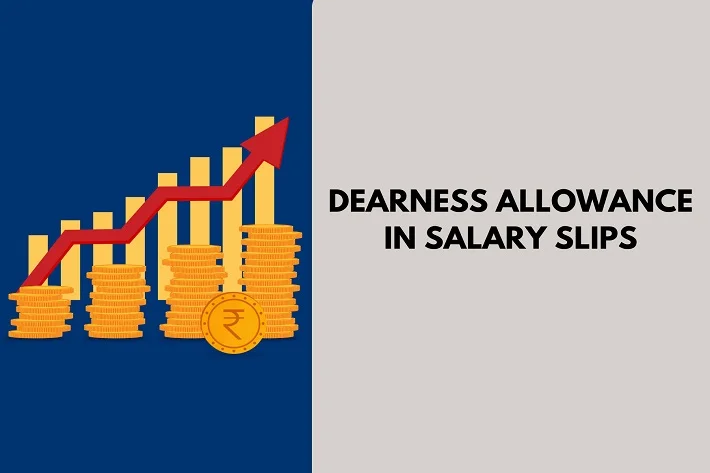Dearness Allowance in salary slips is an additional amount the government pays to employees, pensioners, etc., as a percentage of their base salary. Its purpose is to counterbalance the impact of inflation and rising living costs, with higher allowances typically granted to employees in larger cities. This adjustment helps ensure that the effective salary of an employee adequately accounts for the increasing prices in the market. The calculation of DA as a percentage of basic salary aims to mitigate inflation, with mandatory tax declaration for ITR filing applicable to employees in India and Bangladesh.
What is Dearness Allowance ( DA)?
Dearness allowance is essential to the salary provided to private, public, and government employees. It is a fixed amount payable by the government to all the workers to meet the demand in case of inflation. DA is compulsory for all employees, but the rate may differ sometimes. It creates a balance for all reparations.
An employee gets the DA in salary slips according to the region, such as urban, rural, semi-urban, etc. However, the rate increases accordingly. Usually, urban area employees are likely to get more dearness allowance in salary slips compared to rural areas.
What is the Dearness Allowance in Salary Slip Calculation?
Now that you know about what is the dearness allowance in salary slips, let’s talk about its calculation. The idea of DA in salary slips was introduced in 1945. However, later the government decided to implement this component in the salaries of employees. So in 2006, the present government formed a formula for calculating the DA in salary slips. From then to now, DA in salary slip is calculated according to the below-given procedure:
1. For Central Public sector Employees
Dearness allowance% = (( Average of AICPI ( base year – 2001 =100 ) for the past three months – 126.33 ) /126.33)* 100
In this formula, AICPI refers to The – India Consumer Price Index.
2. For Central Government Employees
Dearness allowance % = (( Average of AICPI ( base year- 2001=100) for the past 12 months – 115.76)/ 115.76)* 100
Types of Dearness Allowance in Salary Slip
The Dearness allowance includes two categories according to the employees and the sector. let us discuss these categories below
1. Industrial Dearness Allowance (IDA)
The dearness allowance includes industrial allowance, which applies to the central government public sector employees. The rate of the industrial dearness allowance is 5%, according to the recent reforms. The IDA is provided to the employees to reduce the collision of inflation. Industrial dearness allowance is emending every quarter after changes in CPI ( Consumer Price Index ).
2. Variable Dearness Allowance (VDA)
The variable dearness allowance applies to the employees of the central government. The variable dearness allowance Is amended on a half-yearly basis. The VAD rate is usually fixed and changes according to CPI ( Consumer Price Index ). However, when we talk about the rate, it remains set until the government reduces or increases the employees’ wages. The only change the variable dearness allowance includes is that CPI keeps changing every month, eventually impacting the VAD.
How is Dearness Allowance Treated Under Income Tax?
Salaried employees, as per the Income Tax Act, must disclose tax liabilities related to Dearness Allowance (DA) in their tax returns. This requirement is especially important if the DA is part of their retirement benefits, which include rent-free accommodation provided by the employer. Accurate disclosure ensures compliance and proper assessment of tax liabilities.
Also Read: Benefits of Filing Income Tax Returns in India
Pay Commissions Role in the Dearness Allowance Calculation
Pay commissions in India have a crucial role in actively reassessing and adjusting salary components, including Dearness Allowance, for public sector employees, ensuring fair and updated compensation aligned with economic conditions.
What Is Dearness Allowance for Pensioners?
The dearness allowance for pensioners is determined based on revisions made to public sector employees’ salaries, ensuring fair compensation with respect to the cost of living changes.
Difference Between DA and HRA
| DA | HRA |
| Only employees of the Central Government and public sector receive the payment of dearness allowance. | Both public and private sector employees get DA and HRA. |
| The basic salary determines the dearness allowance as a fixed percentage. | The calculation of House Rent Allowance (HRA) does not rely on the basis of basic salary. |
| DA is fully taxable. | HRA is partially taxable under Income Tax Act. |
| DA rate is revised periodically. | Until the salary structure changes HRA does not changes. |
Conclusion
In this article, we discussed what is the dearness allowance in salary slips, its types, way of calculation etc. The dearness allowance helps in protecting the government or private employees from usual inflation during the financial year. The dearness allowance is calculated half-yearly according to the employee’s salary. However, it helps the employees to meet their expenses in the situation of costliness.
Dearness Allowance in Salary Slips – FAQs
what is the dearness allowance in the salary slip role?
Ans. The dearness allowance is a part of the monthly salary of the employees. It plays an essential role in the time of inflation. Currently, DA is equal to 50% of an employee’s wages.
What are the factors affecting dearness allowance?
Ans. The three factors that significantly impact dearness allowance include the consumer price index, variable dearness allowance, and base index. The DA remains stable until an employee’s wage gets an increment or decrement.
What is the new DA calculation rule?
Ans. The dearness allowance is calculated by multiplying the current rate of dearness allowance of the commission with the regular pay. The current rate of the percentage of dearness allowance is 7%.
What are the benefits of a dearness allowance?
Ans. Dearness allowance is provided to almost all sector employees. However, it helps the employees in a very beneficial way, as if the dearness allowance increase, then the monthly salary of the employees also increases.
How do the employees get the dearness allowance?
Ans. Dearness allowance is calculated based on the employee’s salary and later added to the total payable amount of the compensation.















